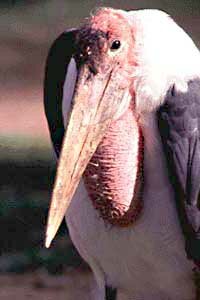 Marabou Stork Marabou Stork
scientific name
Leptoptilos crumeniferus
size/weight/height
Height: male 5' " female slightly smaller
Weight: male 15 - 20 lbs. " female slightly smaller
Wingspan: male 8.5'
largest stork
adaptations/coloration
Color: head pink-red & bare " feathers black " neck white ruff " lower body white " back mantle & upper wing slate gray with green gloss " tail & wings black with green gloss " bill mottled black with pink tint " eyes brown " air sacs red
Flight: not good short distance " soars to great height on thermals " neck tucked in (unlike other storks) " legs projected
Foreneck: lower part has distensible fleshy pouch
Immature: woolly covering on head
Plumage: blackness appears 3 yrs " adult by 4 yrs
behavior
Call: usually silent away from nest
Defense: bill-clacking if threatened
Flock: size varies
Forage: share carcasses with vultures " shake loose large chunks & eat whole " adult can swallow 2 lb. chunk
Movement: when not feeding - standing, squatting, pacing, or wings extend to catch sun & warn off intruders
Personality: gregarious " gather at river sandbanks to bathe & rest
reproduction/lifespan
Lifespan: 25+ years maximum established
Breed: large colony 100+ pairs " same site (tree & cliff) used annually
Courtship: by male " bill clacks, loud hollow sounds, wings spread, neck arches, & sways back & forth
Eggs: 1-4 " laid 1-3 day intervals
Incubation: 30 days " both parents
Nest: male gathers sticks " female builds - takes 7 - 10 days " 3' wide " 33-100' above ground " intruder warning = grunts, squeaks, whistles
Parenting: both parents " 1 remains nearby " food regurgitated by parent into nest
Young: left alone at 10 days " young rely on parents for food 130 days
Sexual Maturity: unknown
diet
Wild: amphibians, aquatic organisms, beetles, carrion, crustaceans, fish, flamingoes, termites & young shore birds
Zoo: Bird of Prey Diet, chicks, fish & mice
habitat/range
near water " fishing villages & garbage dumps " Equatorial Africa - rare south of Botswana or north of Senegal & Somalia
status
population probably increasing due to association with humans & garbage dump scavenging
oregon zoo exhibit
Africa Savanna
back to top
|


